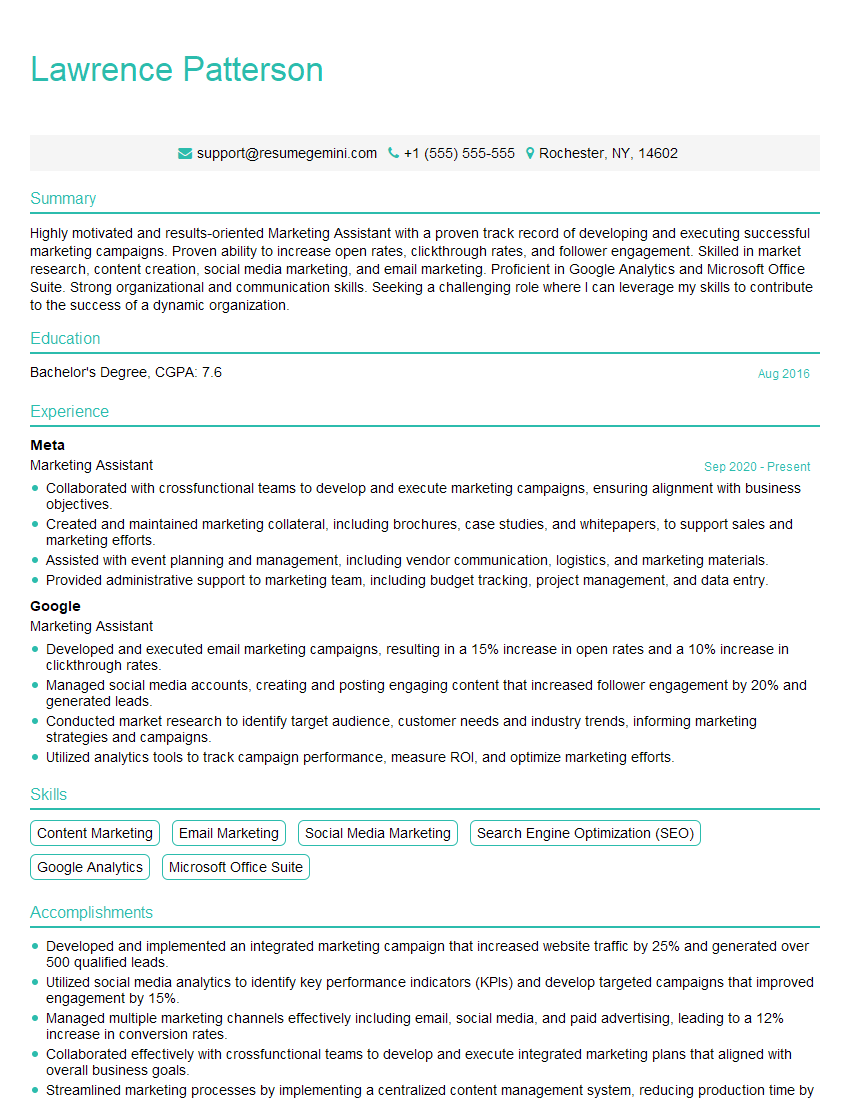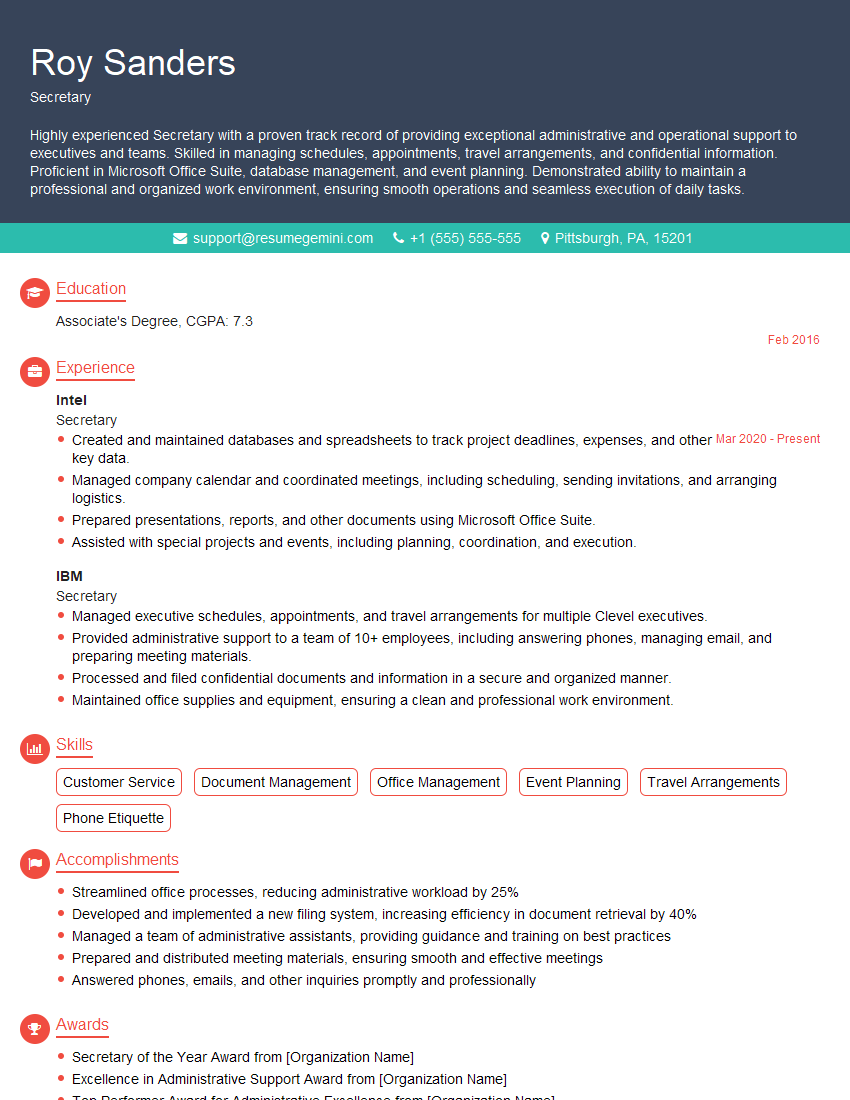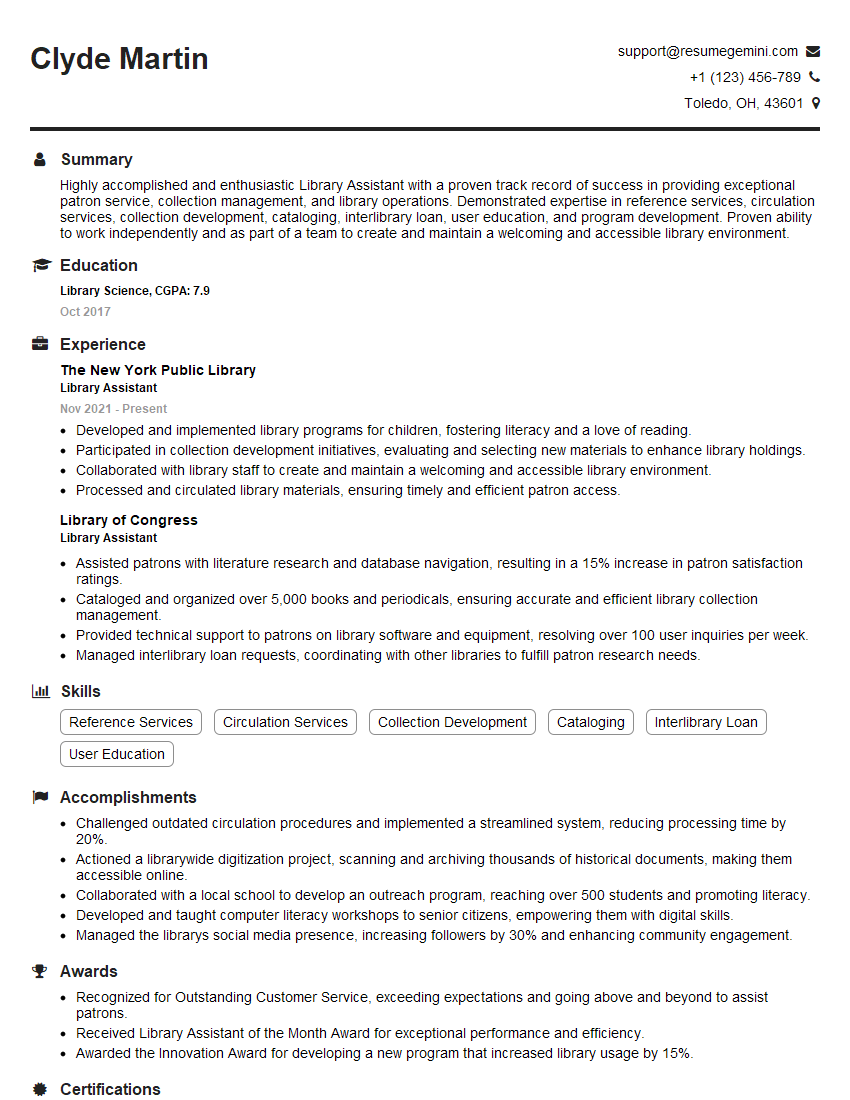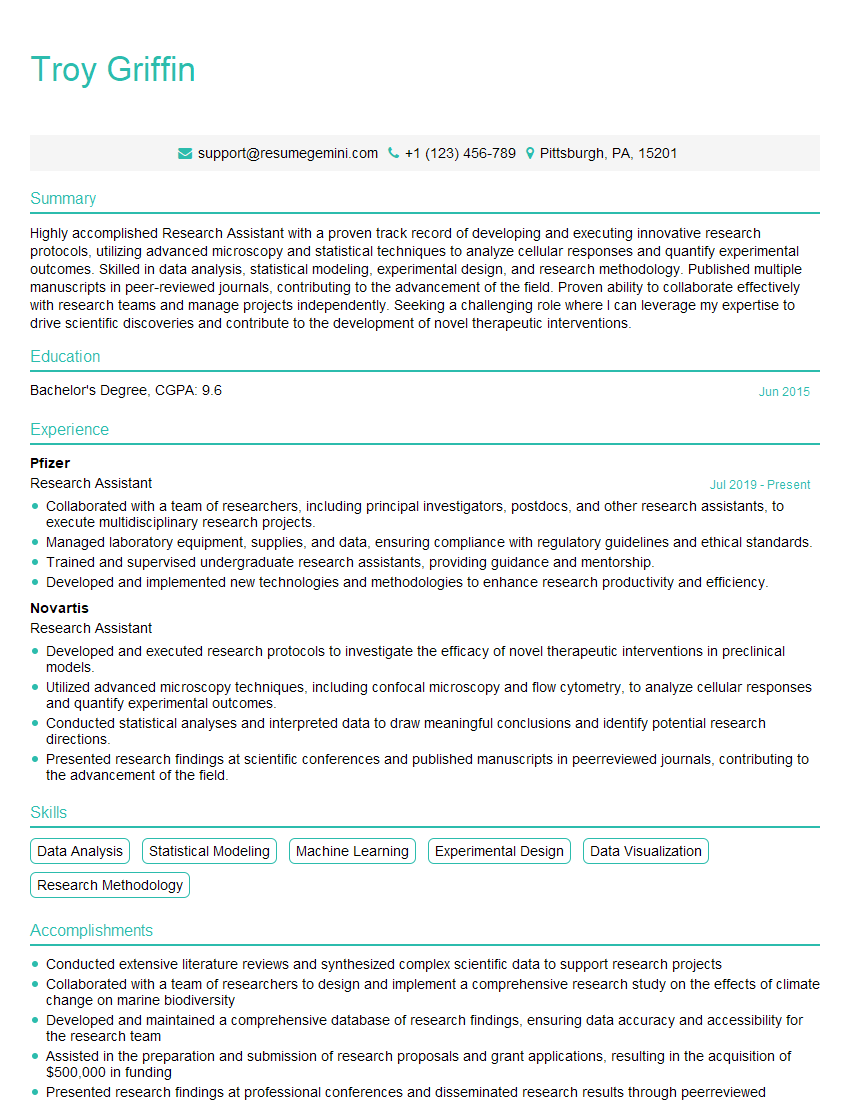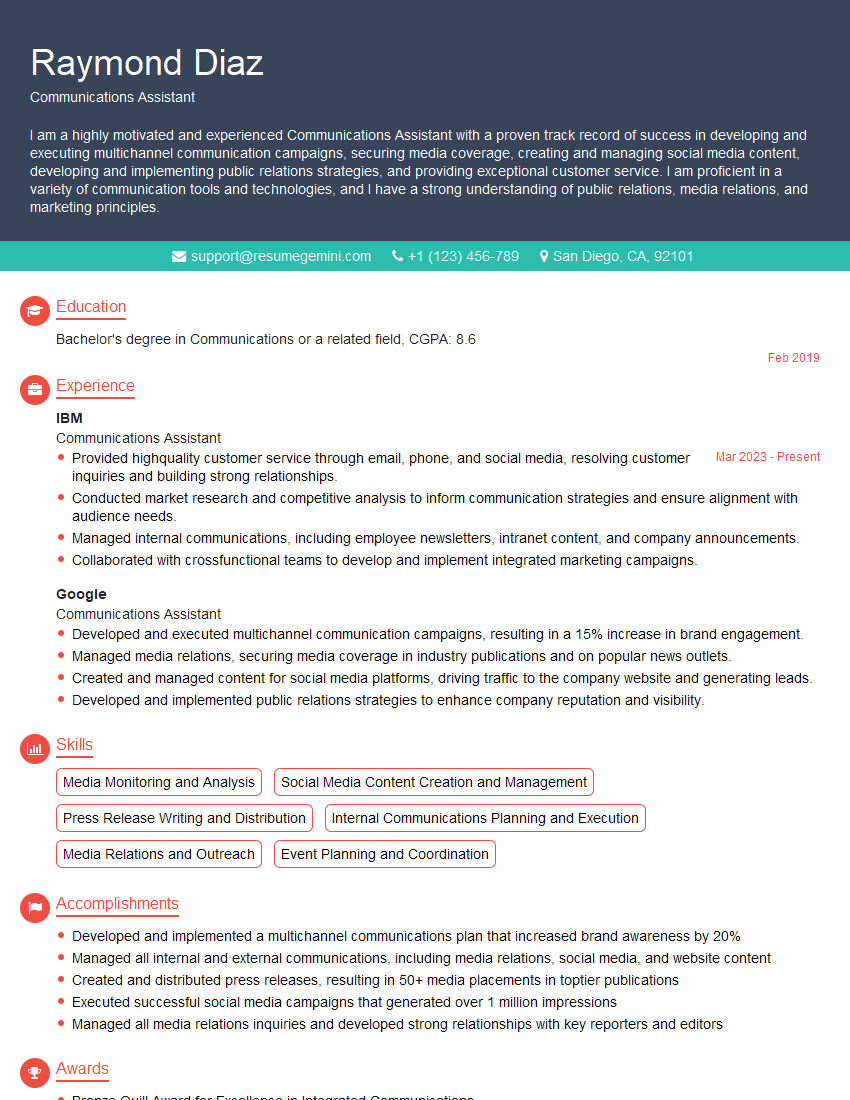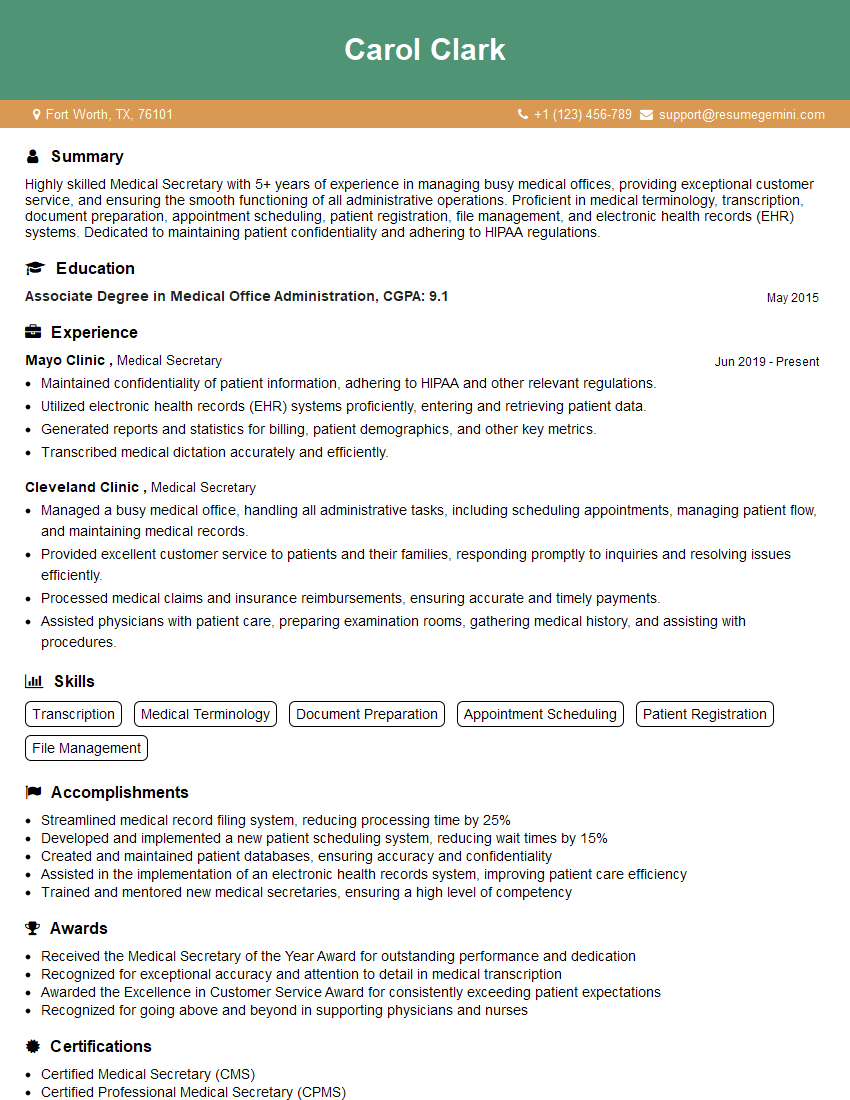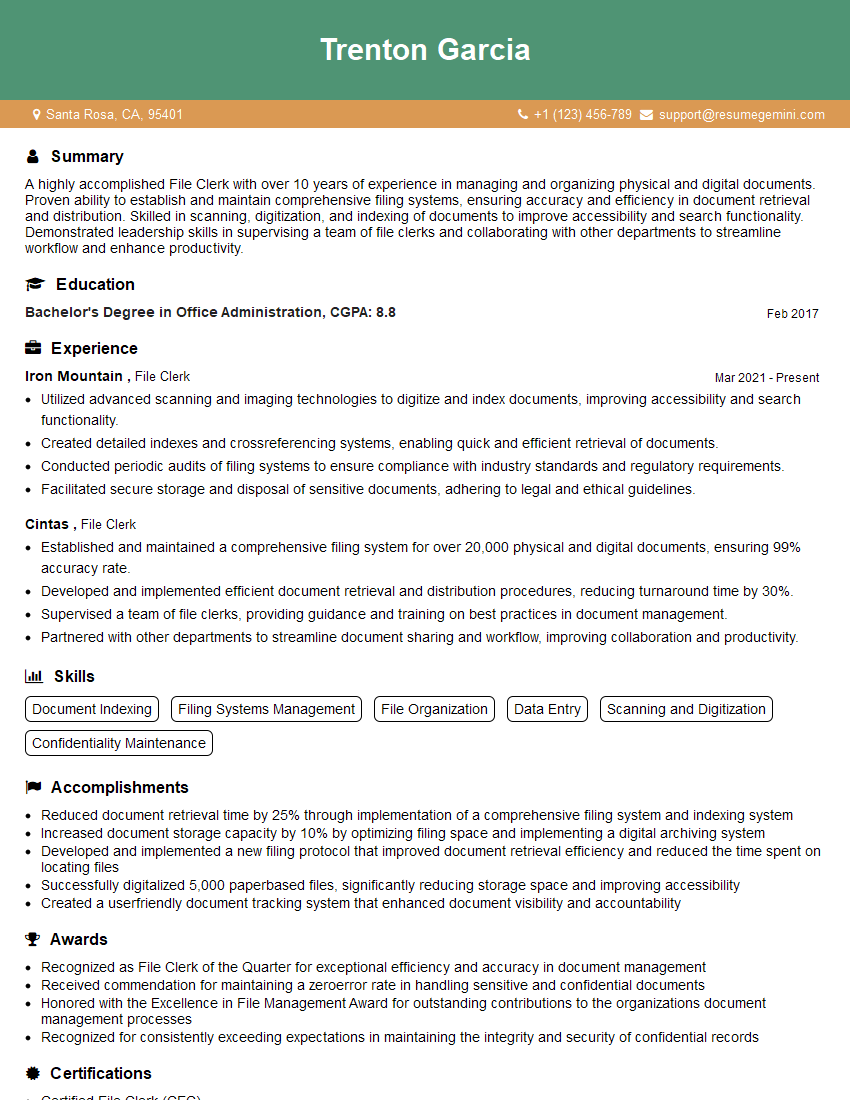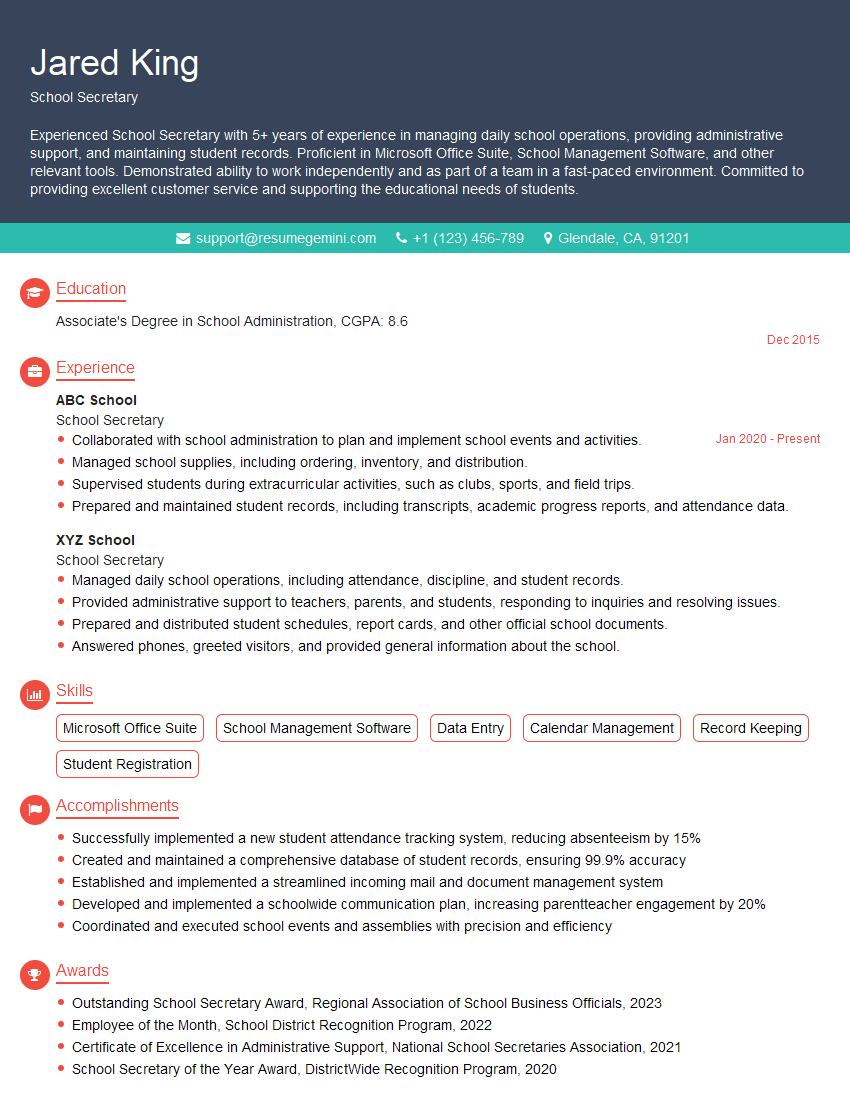Feeling uncertain about what to expect in your upcoming interview? We’ve got you covered! This blog highlights the most important Use basic computer skills interview questions and provides actionable advice to help you stand out as the ideal candidate. Let’s pave the way for your success.
Questions Asked in Use basic computer skills Interview
Q 1. What is your experience with Microsoft Word?
My experience with Microsoft Word spans over 10 years, encompassing everything from basic document creation to advanced features like mail merge and complex table manipulations. I’m proficient in formatting text, inserting images and tables, creating styles, using templates, and tracking changes. For example, I recently used Word to create a comprehensive project proposal, including formatted sections, tables with financial data, and tracked changes reflecting feedback from multiple stakeholders. This allowed for efficient collaboration and a polished final product.
I’m also comfortable with advanced features such as creating macros for repetitive tasks and utilizing the VBA (Visual Basic for Applications) scripting language for automation. Think of automating the process of adding headers, footers, and page numbers to hundreds of documents – a huge time saver!
Q 2. How proficient are you with Microsoft Excel?
I’m highly proficient in Microsoft Excel, possessing expertise in data analysis, visualization, and manipulation. My skills range from basic data entry and formula creation to advanced techniques such as pivot tables, VLOOKUPs, and macros. I’ve extensively used Excel for tasks such as budget management, sales forecasting, and performance analysis.
For instance, I once used Excel to analyze a large dataset of customer information to identify key trends and improve marketing strategies. This involved creating pivot tables to summarize data, using VLOOKUP to cross-reference information from different sheets, and charting the results to visualize key insights. I’m also familiar with using conditional formatting to highlight important data points and data validation to ensure data accuracy.
Q 3. Describe your experience using PowerPoint.
My experience with PowerPoint extends to creating engaging and informative presentations for diverse audiences. I’m adept at designing visually appealing slides, incorporating multimedia elements such as images, videos, and animations, and utilizing transitions and animations to enhance audience engagement. I’m also comfortable using master slides to maintain a consistent design throughout a presentation.
For example, I recently developed a training presentation using PowerPoint, incorporating interactive elements such as quizzes and polls to keep the audience engaged and assess their understanding. I also utilized the presenter view to manage my notes and track my progress during the presentation. My presentations are always meticulously designed to ensure clarity and impact, reflecting a commitment to effective communication.
Q 4. Have you used email applications like Outlook or Gmail?
Yes, I’ve used email applications extensively, including both Outlook and Gmail. I’m proficient in managing emails, organizing them into folders, utilizing filters to prioritize important messages, and scheduling emails for later delivery. I understand the importance of maintaining a professional tone and appropriate email etiquette in business communication.
I routinely use features such as calendar integration for scheduling meetings and tasks, contact management for maintaining a comprehensive address book, and email signatures to maintain a consistent brand identity. I am also adept at managing multiple email accounts and handling large volumes of emails efficiently.
Q 5. How comfortable are you with internet browsing and search engines?
I’m very comfortable with internet browsing and search engines. I utilize various search strategies to efficiently find information online, employing keywords, advanced search operators, and different search engines to locate relevant and accurate information. I also understand the importance of evaluating the credibility of online sources.
For example, I often research industry trends and best practices using Google Scholar and other reputable online databases. I understand how to effectively navigate websites, bookmark useful resources, and utilize browser extensions to enhance productivity and security. I’m also familiar with various browser settings and customizations.
Q 6. Can you explain your experience with file management and organization?
I employ a meticulous approach to file management and organization. I use a hierarchical folder structure, naming conventions, and regular backups to ensure easy retrieval and prevent data loss. I utilize cloud storage solutions to enhance accessibility and data security.
For example, I organize my documents by project, using clear and concise naming conventions to easily identify files. I regularly back up my important files to both external drives and cloud storage services, such as Google Drive or Dropbox. This ensures that my data is protected and readily accessible from multiple locations. My organizational skills have proven invaluable in maintaining a high level of efficiency and preventing critical errors.
Q 7. How do you handle technical issues when using computer software?
When faced with technical issues, I follow a systematic approach to troubleshooting. I start by identifying the problem, searching for solutions online, attempting basic fixes, and escalating the issue if necessary. I’m proficient in using online help resources, forums, and contacting technical support when appropriate.
For instance, if I encounter a software error, I’ll first try restarting the program or computer. If that doesn’t work, I’ll search online forums or the software’s support website for solutions. I document the error messages, steps I’ve taken, and any relevant information to aid in troubleshooting. If the problem persists, I escalate it to the appropriate support team, providing them with the gathered information for efficient resolution.
Q 8. Describe your experience with data entry.
My data entry experience is extensive, encompassing various projects requiring accuracy and speed. I’ve worked with diverse data formats, including spreadsheets, databases, and forms. For example, in my previous role at Acme Corp, I was responsible for inputting customer information into our CRM system, ensuring data integrity and consistency. This involved meticulous attention to detail to minimize errors and maintain data quality. Another project involved cleaning and standardizing a large dataset, requiring me to identify and correct inconsistencies, resulting in a more efficient and reliable database.
I’m proficient in using data entry software and am comfortable adapting to new systems quickly. I understand the importance of data validation and regularly employ techniques such as double-checking entries and using automated validation features to ensure accuracy.
Q 9. What is your experience using a keyboard and mouse?
I’m highly proficient with both keyboards and mice, having used them extensively throughout my career. My typing speed is approximately 70 words per minute with high accuracy, allowing for efficient data entry and document creation. I’m comfortable using various keyboard shortcuts to streamline workflows, such as Ctrl+C (copy) and Ctrl+V (paste) for efficient text manipulation. Beyond basic navigation, I’m adept at using the mouse for precise selections, drag-and-drop operations, and graphical interfaces. Think of it like this: my keyboard and mouse are extensions of my hands, allowing me to interact with the digital world seamlessly and efficiently.
Q 10. How familiar are you with different operating systems (e.g., Windows, macOS)?
I’m familiar with both Windows and macOS operating systems. I’ve used Windows extensively for tasks such as data entry and software application use, while using MacOS for other tasks such as graphic design and video editing. My experience spans multiple versions of both operating systems. This familiarity enables me to navigate different file systems, troubleshoot basic issues, and adapt to various software applications across platforms. For instance, I’ve successfully transferred files between Windows and macOS systems, demonstrating my understanding of cross-platform compatibility issues and solutions. I find the core functionalities across both operating systems quite similar; only certain application-specific tasks require a slightly altered approach.
Q 11. Have you used any cloud storage services (e.g., Google Drive, Dropbox)?
Yes, I’ve used several cloud storage services, including Google Drive and Dropbox. I understand the advantages of cloud storage for collaboration, data backup, and accessibility from multiple devices. In previous roles, I’ve utilized Google Drive for team projects, allowing for seamless sharing and version control. I understand file permissions and sharing settings, ensuring data security and appropriate access. Dropbox has been instrumental for personal file backup and synchronization across my devices. My experience extends to managing storage space, understanding file structures within the cloud, and troubleshooting potential access or synchronization issues.
Q 12. What is your experience with printers and scanners?
My experience with printers and scanners is practical and encompasses various types and functionalities. I’m comfortable using both inkjet and laser printers for document printing, understanding print settings and troubleshooting minor issues like paper jams. Regarding scanners, I have experience using both flatbed and sheet-fed scanners to digitize documents and images, ensuring high-quality scans through the use of appropriate settings. I am familiar with different file formats produced by scanners, such as JPEG and PDF, and know how to properly name and save those files for optimal organization. I also have basic knowledge of scanning software and driver installation.
Q 13. How do you typically save and organize your files?
I maintain a well-organized file system using a hierarchical structure. I typically create folders by project, date, or client name. Within each folder, I use descriptive file names to easily locate specific documents. This method is based on the concept of using meaningful names and logical groupings. For example, a project folder might contain subfolders for ‘documents’, ‘images’, and ‘spreadsheets’. This strategy allows for easy retrieval and efficient management of large volumes of data. I also regularly review and archive older files to maintain an efficient system and prevent data clutter.
Q 14. Describe your experience with copying and pasting text and files.
Copying and pasting text and files is a fundamental skill I use daily. I’m proficient in using keyboard shortcuts (Ctrl+C and Ctrl+V on Windows, Cmd+C and Cmd+V on macOS) for quick and efficient text and file transfer. I understand the importance of using the correct method based on the file type and intended use. For instance, when copying large files, I understand the process might involve moving files physically (especially if speed and bandwidth are issues), whereas text can be easily copied and pasted directly into different applications. I also understand the implications of pasting formatted text into different applications and how to adjust formatting as necessary to preserve the visual integrity of the document.
Q 15. How familiar are you with using different file formats (e.g., .doc, .pdf, .xls)?
I’m highly proficient with various file formats commonly used in professional settings. My experience encompasses the Microsoft Office suite (.doc, .docx for Word documents; .xls, .xlsx for Excel spreadsheets; .pptx for PowerPoint presentations), PDF (.pdf) files for document sharing and archiving, and image formats like JPEG (.jpg) and PNG (.png). I understand the nuances of each format – for instance, the editing capabilities of .doc vs. the read-only nature of PDFs unless specifically edited with a PDF editor. I can also readily convert between formats as needed using various tools and applications.
For example, I regularly convert Excel spreadsheets (.xlsx) into PDFs (.pdf) for easier distribution and to ensure consistent formatting across different operating systems. I also utilize the capability to embed Excel spreadsheets into Word documents (.docx) to streamline reporting and analysis.
Career Expert Tips:
- Ace those interviews! Prepare effectively by reviewing the Top 50 Most Common Interview Questions on ResumeGemini.
- Navigate your job search with confidence! Explore a wide range of Career Tips on ResumeGemini. Learn about common challenges and recommendations to overcome them.
- Craft the perfect resume! Master the Art of Resume Writing with ResumeGemini’s guide. Showcase your unique qualifications and achievements effectively.
- Don’t miss out on holiday savings! Build your dream resume with ResumeGemini’s ATS optimized templates.
Q 16. How comfortable are you with troubleshooting basic computer problems?
Troubleshooting basic computer problems is a regular part of my workflow. I approach these issues methodically, starting with simple checks and progressively moving towards more advanced solutions. This often involves assessing the problem’s nature: Is it a hardware or software issue? Is it a network connectivity problem, or is it related to a specific application?
- Step 1: Identifying the Problem: Clearly define the error message or the problem’s symptoms. This crucial step guides the following troubleshooting steps.
- Step 2: Basic Checks: Restart the computer, check cable connections, ensure the power supply is stable, and check for any obvious physical damage.
- Step 3: Software Diagnostics: Check for software conflicts, update drivers, run virus scans, and look for error logs within the affected application.
- Step 4: Online Resources: Consult online help documents, support forums, or knowledge bases for solutions to common errors.
For instance, I recently helped a colleague resolve a printer connectivity issue by checking the network settings and restarting the printer and computer. By systematically eliminating possible causes, I quickly identified the problem and restored functionality.
Q 17. What is your experience with software updates and installations?
I have extensive experience with software updates and installations. I understand the importance of keeping software up-to-date for security and functionality. My process involves carefully reviewing release notes for any potential conflicts or compatibility issues before initiating an update or installation. I also understand the differences between manual and automatic updates, and I’m comfortable using both methods depending on the software and the situation.
For example, when installing a new software application, I always make sure to back up important data before beginning. I also follow the installation instructions closely and pay close attention to any error messages that might occur during the process. In case of automatic updates, I make sure to schedule them during off-peak hours to minimize any potential disruptions to workflow.
Q 18. Have you ever used video conferencing software (e.g., Zoom, Skype)?
Yes, I’m very comfortable using video conferencing software like Zoom and Skype. I regularly use these platforms for meetings, presentations, and collaborating with colleagues and clients remotely. My experience includes scheduling meetings, managing participants, sharing screens, using chat functions, and recording sessions.
I understand the importance of appropriate etiquette in online meetings, including muting microphones when not speaking, ensuring a clean and professional background, and being mindful of time constraints. I’ve also used these platforms to conduct online training sessions, demonstrating how to use specific software or share information effectively.
Q 19. Are you comfortable with using social media platforms for professional purposes?
I am comfortable using social media platforms for professional purposes, primarily LinkedIn. I understand the importance of maintaining a professional online presence and using these platforms strategically for networking, sharing industry insights, and engaging with potential clients and collaborators. I adhere to professional standards, ensuring my posts are respectful, relevant, and aligned with my professional image.
My approach focuses on using LinkedIn to build my professional network, share relevant articles and updates in my field, and participate in industry discussions. I avoid sharing overly personal information and always consider the implications of my online interactions.
Q 20. Describe a time you had to learn a new computer program quickly.
In my previous role, I needed to quickly learn a new Customer Relationship Management (CRM) software within a week to effectively manage client interactions. I used a multi-pronged approach:
- Self-Guided Learning: I started by thoroughly reviewing the software’s online documentation and tutorials.
- Hands-on Practice: I created test accounts and experimented with different features to understand their functionality.
- Seeking Assistance: I sought help from colleagues familiar with the software and asked specific questions about the functionalities that were unclear.
- Prioritization: I prioritized learning the core features critical for my day-to-day tasks, leaving less critical aspects for later exploration.
Through this combination of methods, I became proficient in using the CRM software well within the given timeframe and successfully integrated it into my workflow.
Q 21. How do you stay updated on new computer technologies?
I stay updated on new computer technologies through a variety of methods, ensuring I remain current with industry best practices and advancements. These include:
- Industry Publications: I regularly read tech news websites, blogs, and magazines to stay informed about emerging technologies and trends.
- Professional Networking: I actively participate in online forums and communities dedicated to computer technology to exchange ideas and learn from peers.
- Online Courses and Webinars: I utilize online learning platforms to take courses and attend webinars focusing on specific technologies of interest.
- Industry Conferences and Events: When possible, I attend industry conferences and workshops to engage with leading experts and learn about cutting-edge developments.
This approach ensures that my skills remain relevant and allows me to adapt quickly to evolving technological landscapes.
Q 22. What are some shortcuts you frequently use?
I frequently use a variety of keyboard shortcuts to boost my efficiency. Think of them as power-ups for productivity! For example, Ctrl+C (or Cmd+C on a Mac) for copy and Ctrl+V (or Cmd+V) for paste are indispensable for moving text and data around. I also heavily rely on Ctrl+Z (or Cmd+Z) for undo, saving me from countless potential errors. For navigation, Ctrl+F (or Cmd+F) for find is incredibly useful for locating specific information within a document, and Ctrl+S (or Cmd+S) for saving my work frequently prevents data loss. Finally, Ctrl+A (or Cmd+A) to select all is a time-saver when I need to edit or format a whole document.
Beyond these basics, I utilize shortcuts specific to the applications I use regularly. For instance, in Microsoft Word, I use Ctrl+B for bold and Ctrl+I for italics frequently. These seemingly small time-savers accumulate significant efficiency gains over the course of a day.
Q 23. What is your typing speed?
My typing speed is approximately 75 words per minute with a high degree of accuracy. I’ve consistently maintained this speed through years of practice and focus on proper typing technique. I understand that speed is important, but accuracy is paramount. Making many errors negates the benefits of high typing speed. I prioritize accuracy to ensure error-free work.
Q 24. Can you explain your experience with different types of computer software?
My experience with computer software spans a wide range of applications. I am proficient in Microsoft Office Suite (Word, Excel, PowerPoint, Outlook), Google Workspace (Docs, Sheets, Slides, Gmail), and various other software depending on the task. For example, I’m comfortable using Adobe Acrobat for PDF management, and I have experience with various graphic design and image editing programs including Photoshop and GIMP. My experience isn’t limited to just these; I am also comfortable learning new software as required. I’m a quick study and approach software learning with a focus on understanding the software’s logical structure and functionality.
Furthermore, I’m familiar with operating systems like Windows and macOS, and I have experience with basic command-line interfaces. This breadth of experience allows me to adapt to various software and hardware environments quickly and effectively.
Q 25. Describe your experience with basic data analysis using spreadsheets.
I have extensive experience using spreadsheets for basic data analysis. My skills include data entry, cleaning and manipulation, creating formulas for calculations (e.g., SUM, AVERAGE, COUNTIF), using functions for more complex analysis (e.g., VLOOKUP, INDEX/MATCH), building charts and graphs to visualize data trends, and utilizing data filters and sorting to organize information effectively. For example, I’ve used spreadsheets to track project budgets, analyze sales data to identify trends, and compare different datasets to inform decision-making.
I understand the importance of data integrity and take careful steps to ensure accuracy. This includes double-checking data entry, using formula auditing tools, and validating results against expectations. My goal is always to extract meaningful insights from data in a clear and easily understood way.
Q 26. Can you share an example of how you used computer skills to solve a problem?
In a previous role, our team faced a challenge with managing project timelines. We were using a cumbersome manual system involving multiple spreadsheets and email chains, leading to frequent miscommunications and missed deadlines. I proposed using a project management software solution which offered improved task organization, progress tracking, and automated notifications.
I took the initiative to learn the software quickly, create a customized workflow for our team, and then trained my colleagues on its effective use. This transition streamlined our project management considerably, reducing errors, improving communication, and helping us meet deadlines more consistently. The problem was solved by leveraging my computer skills in project management software to create a more efficient system.
Q 27. What are your strengths and weaknesses when it comes to computer skills?
One of my greatest strengths is my adaptability and willingness to learn new software. I’m a quick learner and enjoy staying updated on current technologies and best practices. I also possess strong problem-solving skills, which allows me to troubleshoot software issues and find efficient solutions.
However, a potential area for improvement could be my advanced coding skills. While I have a basic understanding of several programming languages, I am eager to deepen my expertise in this area to further enhance my contributions. I’m actively working to improve in this area through online courses and personal projects.
Q 28. Where do you see yourself improving your computer skills in the future?
I plan to enhance my computer skills in the future by focusing on advanced data analysis techniques, including SQL database management and advanced statistical software packages like R or Python. I also plan to improve my proficiency in programming languages like Python for automation and data manipulation. These skills are highly valuable in today’s data-driven world and align with my career aspirations.
Continuous learning is crucial in the technology field and I am committed to staying current with industry trends and acquiring new skills to enhance my effectiveness and contribute to future projects effectively.
Key Topics to Learn for Basic Computer Skills Interview
- File Management: Understanding file systems, creating folders, organizing files, moving, copying, and deleting files. Practical application: Demonstrate your ability to efficiently manage files for a project, ensuring easy retrieval and organization.
- Operating Systems (OS): Familiarity with common OS interfaces (Windows, macOS, Linux), basic troubleshooting, and understanding of core functionalities. Practical application: Describe how you’ve resolved a simple OS-related issue, showcasing problem-solving skills.
- Software Applications: Proficiency in common productivity software (word processing, spreadsheets, presentations). Practical application: Be ready to discuss your experience using these tools and how you’ve leveraged them to complete tasks efficiently.
- Internet & Email: Navigating the internet, using search engines effectively, composing and managing emails professionally. Practical application: Explain how you’ve used the internet for research or communication in a professional context.
- Data Entry & Accuracy: Demonstrating the ability to accurately and efficiently input data, paying attention to detail. Practical application: Be prepared to discuss your experience with data entry tasks and strategies for maintaining accuracy.
- Basic Troubleshooting: Identifying and resolving common computer issues such as printer problems, connectivity issues, or software malfunctions. Practical application: Provide examples of how you’ve approached and solved simple technical problems independently.
- Data Security & Privacy: Understanding basic concepts of data security, password management, and responsible online behavior. Practical application: Discuss your approach to protecting sensitive information and adhering to online safety protocols.
Next Steps
Mastering basic computer skills is crucial for success in today’s job market. These skills are foundational for nearly every role and demonstrate your adaptability and efficiency. To maximize your job prospects, create an ATS-friendly resume that highlights your abilities. ResumeGemini is a trusted resource that can help you build a professional and impactful resume. Examples of resumes tailored to showcasing basic computer skills are available to help you craft a compelling application.
Explore more articles
Users Rating of Our Blogs
Share Your Experience
We value your feedback! Please rate our content and share your thoughts (optional).
What Readers Say About Our Blog
Hi, I’m Jay, we have a few potential clients that are interested in your services, thought you might be a good fit. I’d love to talk about the details, when do you have time to talk?
Best,
Jay
Founder | CEO

